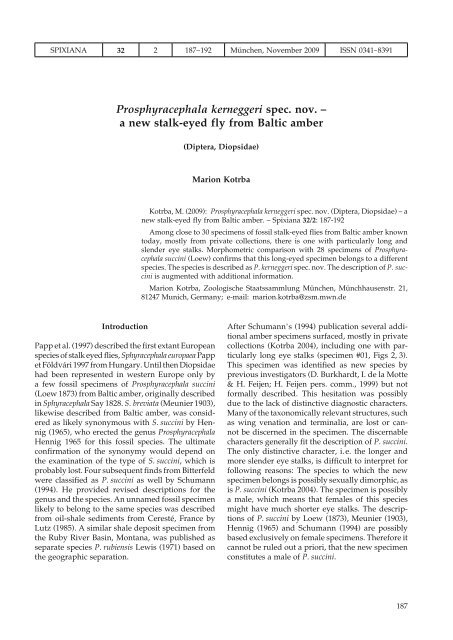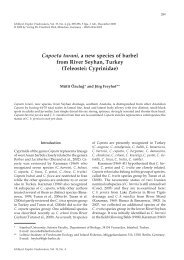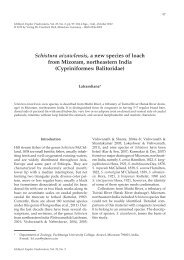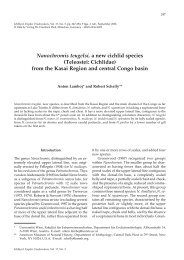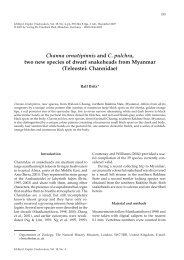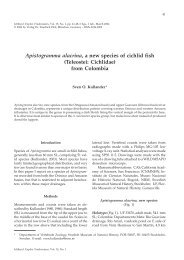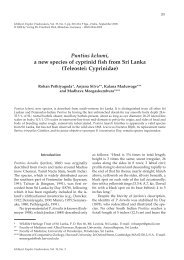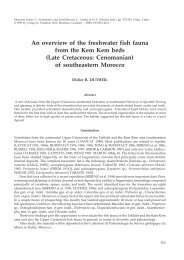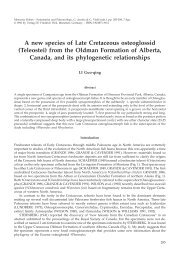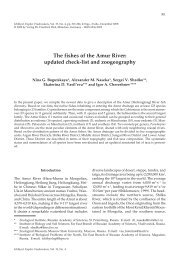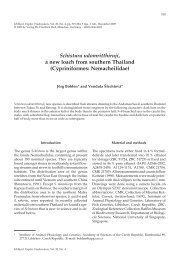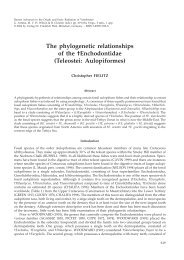Prosphyracephala kerneggeri spec. nov. - Verlag Dr. Friedrich Pfeil
Prosphyracephala kerneggeri spec. nov. - Verlag Dr. Friedrich Pfeil
Prosphyracephala kerneggeri spec. nov. - Verlag Dr. Friedrich Pfeil
Create successful ePaper yourself
Turn your PDF publications into a flip-book with our unique Google optimized e-Paper software.
SPIXIANA 32 2 187–192 München, November 2009 ISSN 0341–8391<br />
<strong>Prosphyracephala</strong> <strong>kerneggeri</strong> <strong>spec</strong>. <strong>nov</strong>. –<br />
a new stalk-eyed fly from Baltic amber<br />
(Diptera, Diopsidae)<br />
Marion Kotrba<br />
Kotrba, M. (2009): <strong>Prosphyracephala</strong> <strong>kerneggeri</strong> <strong>spec</strong>. <strong>nov</strong>. (Diptera, Diopsidae) – a<br />
new stalk-eyed fly from Baltic amber. – Spixiana 32/2: 187-192<br />
Among close to 30 <strong>spec</strong>imens of fossil stalk-eyed flies from Baltic amber known<br />
today, mostly from private collections, there is one with particularly long and<br />
slender eye stalks. Morphometric comparison with 28 <strong>spec</strong>imens of <strong>Prosphyracephala</strong><br />
succini (Loew) confirms that this long-eyed <strong>spec</strong>imen belongs to a different<br />
<strong>spec</strong>ies. The <strong>spec</strong>ies is described as P. <strong>kerneggeri</strong> <strong>spec</strong>. <strong>nov</strong>. The description of P. succini<br />
is augmented with additional information.<br />
Marion Kotrba, Zoologische Staatssammlung München, Münchhausenstr. 21,<br />
81247 Munich, Germany; e-mail: marion.kotrba@zsm.mwn.de<br />
Introduction<br />
Papp et al. (1997) described the first extant European<br />
<strong>spec</strong>ies of stalk eyed flies, Sphyracephala europaea Papp<br />
et Földvári 1997 from Hungary. Until then Diopsidae<br />
had been represented in western Europe only by<br />
a few fossil <strong>spec</strong>imens of <strong>Prosphyracephala</strong> succini<br />
(Loew 1873) from Baltic amber, originally described<br />
in Sphyr acephala Say 1828. S. breviata (Meunier 1903),<br />
likewise described from Baltic amber, was considered<br />
as likely synonymous with S. succini by Hennig<br />
(1965), who erected the genus <strong>Prosphyracephala</strong><br />
Hennig 1965 for this fossil <strong>spec</strong>ies. The ultimate<br />
confirmation of the synonymy would depend on<br />
the examination of the type of S. succini, which is<br />
probably lost. Four subsequent finds from Bitterfeld<br />
were classified as P. succini as well by Schumann<br />
(1994). He provided revised descriptions for the<br />
genus and the <strong>spec</strong>ies. An unnamed fossil <strong>spec</strong>imen<br />
likely to belong to the same <strong>spec</strong>ies was described<br />
from oil-shale sediments from Ceresté, France by<br />
Lutz (1985). A similar shale deposit <strong>spec</strong>imen from<br />
the Ruby River Basin, Montana, was published as<br />
separate <strong>spec</strong>ies P. rubiensis Lewis (1971) based on<br />
the geographic separation.<br />
After Schumann’s (1994) publication several additional<br />
amber <strong>spec</strong>imens surfaced, mostly in private<br />
collections (Kotrba 2004), including one with particularly<br />
long eye stalks (<strong>spec</strong>imen #01, Figs 2, 3).<br />
This <strong>spec</strong>imen was identified as new <strong>spec</strong>ies by<br />
previous investigators (D. Burkhardt, I. de la Motte<br />
& H. Feijen; H. Feijen pers. comm., 1999) but not<br />
formally described. This hesitation was possibly<br />
due to the lack of distinctive diagnostic characters.<br />
Many of the taxonomically relevant structures, such<br />
as wing venation and terminalia, are lost or cannot<br />
be discerned in the <strong>spec</strong>imen. The discernable<br />
characters generally fit the description of P. succini.<br />
The only distinctive character, i. e. the longer and<br />
more slender eye stalks, is difficult to interpret for<br />
following reasons: The <strong>spec</strong>ies to which the new<br />
<strong>spec</strong>imen belongs is possibly sexually dimorphic, as<br />
is P. succini (Kotrba 2004). The <strong>spec</strong>imen is possibly<br />
a male, which means that females of this <strong>spec</strong>ies<br />
might have much shorter eye stalks. The descriptions<br />
of P. succini by Loew (1873), Meunier (1903),<br />
Hennig (1965) and Schumann (1994) are possibly<br />
based exclusively on female <strong>spec</strong>imens. Therefore it<br />
cannot be ruled out a priori, that the new <strong>spec</strong>imen<br />
constitutes a male of P. succini.<br />
187
The present study establishes the intra<strong>spec</strong>ific<br />
variation for a number of measurements such as<br />
eye span, body length, thorax width and eye stalk<br />
diameter for males and females of P. succini based<br />
on measurements taken from 28 fossil <strong>spec</strong>imens.<br />
Comparison of the re<strong>spec</strong>tive values in the new<br />
<strong>spec</strong>imen with the ranges established for P. succini<br />
shows that it belongs to neither sex of that <strong>spec</strong>ies<br />
but indeed represents a different and therefore new<br />
<strong>spec</strong>ies which is formally described here.<br />
Material and methods<br />
The <strong>spec</strong>imens studied and their re<strong>spec</strong>tive depositories<br />
are listed in Table 1. In addition to the new <strong>spec</strong>imen<br />
(#01), 27 <strong>spec</strong>imens of P. succini from Baltic amber (including<br />
Bitterfeld amber) were investigated, including<br />
the holotype of P. breviata (#21). The type material of<br />
P. succini was not available for this study. It is probably<br />
lost. Measurements of the oil-shale <strong>spec</strong>imen described<br />
by Lutz (1985) were taken from the published photograph<br />
(#19).<br />
The following morphometric parameters were measured:<br />
eye span E (distance between the lateral eye<br />
margins), eye stalk diameter D (at the narrowest point),<br />
body length L (distance between face and posterior end<br />
of the abdomen or tips of folded wings, whichever could<br />
be determined), and thorax width T. Additionally the<br />
gender of the <strong>spec</strong>imens was recorded. Regression lines<br />
and 95 % confidence intervals in Fig. 1 were computed<br />
with Student Minitab 14. A morphometric analysis<br />
of the measurements of P. succini was published by<br />
Kotrba (2004).<br />
The <strong>spec</strong>imens were studied using a Leica MZ12 stereoscope<br />
equipped with drawing tube and Zeiss AxioCam<br />
Table 1. Depositories and measurements (in mm) of the investigated <strong>spec</strong>imens. E: eye span; L: body length;<br />
T: thorax width; D: diameter of eye stalk; IMGPG: Institut und Museum für Geologie und Paläontologie Göttingen;<br />
MNHUB: Museum für Naturkunde der Humboldt-Universität zu Berlin; ZSM: Zoologische Staatssammlung<br />
München.<br />
Nr. depository sex E L T D remarks<br />
1 ZSM ? 4.78 5.3 1.25 0.25 holotype P. <strong>kerneggeri</strong><br />
2 Coll. Ernst, P. & K. Nordmann, Skagen M 2.52 4.08 1.32 0.30<br />
3 Coll. Gröhn, C., Glinde ? 2.94 ? ? 0.44<br />
4 Coll. Gröhn, C., Glinde W ? 4.30 ? ?<br />
5 Coll. Herrling, A., Bramsche ? 3.03 4.44 1.34 0.32<br />
6 Coll. Herrling, A., Bramsche W 1.45 3.30 ? 0.25<br />
7 Coll. Herrling, A., Bramsche W 1.75 3.71 0.93 0.33<br />
8 Coll. Herrling, A., Bramsche M 2.21 3.98 1.09 0.31<br />
9 Coll. Hoffeins, C. & H. W., Hamburg W 2.00 4.05 1.10 0.35<br />
10 Coll. Hoffeins, C. & H. W., Hamburg W 2.11 3.68 ? ? strongly distended<br />
11 Coll. Krümmer, H. J., Greifswald M 2.50 4.40 ? 0.24<br />
12 Coll. Krylov, A. D., Kaliningrad W 2.20 4.60 1.15 0.35<br />
13 Coll. Krylov, A. D., Kaliningrad M 1.95 3.60 1.00 0.30<br />
14 Coll. Kutscher, M., Sassnitz W 1.94 4.25 0.97 0.30<br />
15 Coll. Kutscher, M., Sassnitz W 2.63 5.11 1.43 0.39<br />
16 Coll. Kutscher, M., Sassnitz W 2.25 5.00 1.19 0.37<br />
17 Coll. Ludwig, W., Berlin W 2.05 4.45 ? 0.39<br />
18 Coll. Ludwig, W., Berlin W 2.16 4.72 1.22 0.39<br />
19 Lutz (1985) ? 2.65 5.1 1.4 0.35 oil-shale <strong>spec</strong>imen<br />
20 IMGPG W 2.00 4.14 ? 0.36<br />
21 IMGPG W 2.60 5.20 1.42 0.47 holotype S. breviata<br />
22 MNHUB ? 2.56 ? ? 0.28<br />
23 MNHUB W 1.50 3.75 0.95 0.26<br />
24 MNHUB M 2.58 4.70 1.24 0.24<br />
25 Natural History Museum Krakow M 2.80 4.35 1.25 0.27<br />
26 Coll. Teuber, D., Gütersloh M 1.75 3.31 1.00 0.25<br />
27 Coll. Velten, J., Idstein ? 1.89 ? ? ?<br />
28 Coll. Velten, J., Idstein M 3.25 4.30 1.25 0.25<br />
29 Coll. Wenzel, H., Bielefeld M 2.70 4.40 ? 0.35<br />
188
eye span (E) [mm]<br />
5<br />
4<br />
3<br />
2<br />
1<br />
10<br />
19<br />
01<br />
21<br />
eye span (E) [mm]<br />
5<br />
4<br />
3<br />
2<br />
1<br />
01<br />
19<br />
21<br />
eye span (E) / eye stalk diameter (D)<br />
20<br />
15<br />
10<br />
5<br />
21<br />
01<br />
19<br />
0<br />
0<br />
0<br />
3 4 5 0.8 1.0 1.2 1.4<br />
female unsexed male<br />
a body length (L) [mm] b thorac width (T) [mm] c<br />
Fig. 1. Morphometric analysis of P. succini and P. <strong>kerneggeri</strong> <strong>spec</strong>. <strong>nov</strong>. a, eye span (E) as a function of body length<br />
(L); b, eye span (E) as a function of thorax width (T); c, ratio of eye span (E) and eye stalk diameter (D). $: males;<br />
#: females; !: unsexed <strong>spec</strong>imens; &: P. <strong>kerneggeri</strong> <strong>spec</strong>. <strong>nov</strong>. Regression lines and 95 % confidence interval (hatched)<br />
added for males and females. Numbers refer to Table 1.<br />
digital camera. Some of the amber pieces were temporarily<br />
submerged in water to reduce distortion effects<br />
without altering the <strong>spec</strong>imen. Each amber <strong>spec</strong>imen<br />
differs in which characters are revealed or hidden due<br />
to its particular position in the stone and to inclusions<br />
of air, particles, swirls etc. in the stone. Therefore it was<br />
impossible to take all measurements in all <strong>spec</strong>imens.<br />
A few of the data are approximations rather than exact<br />
measurements (see Kotrba 2004). In some <strong>spec</strong>imens<br />
the terminalia were not clearly visible but the gender<br />
could be determined from the shape of the abdominal<br />
tip. Where the tip of the abdomen was entirely lost the<br />
gender could not be inferred.<br />
For a detailed general description of diopsid morphology<br />
see Feijen (1989).<br />
Results<br />
The individual measurements are listed in Table 1.<br />
Figure 1 illustrates the ratios of eye span to body<br />
length (Fig. 1a), eye span to thorax width (Fig. 1b)<br />
and eye span to eye stalk diameter (Fig. 1c) for the<br />
male, female and unsexed <strong>spec</strong>imens separately. The<br />
new <strong>spec</strong>imen (#01) is clearly separated from the<br />
rest of the sample. Its eye span is distinctly larger<br />
not only with re<strong>spec</strong>t to the estimated body length<br />
but also with re<strong>spec</strong>t to the thorax width. The ratio<br />
of eye span to eye stalk diameter, which constitutes<br />
a character independent of overall body size, is<br />
also much larger. The new <strong>spec</strong>imen is therefore<br />
described as new <strong>spec</strong>ies.<br />
<strong>Prosphyracephala</strong> succini (Loew)<br />
Sphyracephala succini Loew 1873: 102. Holotype, sex<br />
unknown, Baltic amber, type probably lost.<br />
Sphyracephala breviata Meunier 1903: 404. Holotype,<br />
female, Baltic amber (examined).<br />
<strong>Prosphyracephala</strong> succini Hennig 1965: 63. New combination.<br />
The diagnostic characters provided by Loew (1873),<br />
Meunier (1902), Hennig (1965) and Schumann (1994)<br />
are summarized below.<br />
Description. Eye stalks present, inner and outer<br />
vertical bristles present, arista three-segmented, thorax<br />
with only two pairs of bristles, i. e. the intraalar<br />
bristles and the apical bristles on top of the scutellar<br />
spines; posterior notopleural bristles lacking; scutellum<br />
comparatively short and wide; scutellar spines<br />
about as long as scutellum, spaced far apart; apical<br />
bristles as long as scutellar spines; pointed pleurotergal<br />
spines present; basal section of R 4+5 about 3<br />
times as long as anterior crossvein r-m; CuA 1 not<br />
reaching wing margin, axillar lobe narrow; anal cell<br />
short, not narrowed; apical portion of anal vein in<br />
slightly angled continuation of posterior border of<br />
anal cell, not reaching wing margin; femur of foreleg<br />
incrassate, ventrally adorned with double rows of<br />
3-6 bristles each and twice as many spines.<br />
The present study of 28 fossil <strong>spec</strong>imens of<br />
P. succini allows to add or redefine the following<br />
characters: crossvein bm-cu absent; alula reduced<br />
(in contrast to Hennig’s (1965) description, but in<br />
189
ageement with Schumann’s (1994) illustration); anal<br />
cell short, almost as narrow as in Sphyracephala (see<br />
Kotrba 2004); wing entirely covered with microtrichia;<br />
precoxal bridge not closed. Size ranges (mm):<br />
body length: 3.31-4.70 (males), 3.30-5.20 (females);<br />
eye span: 1.75-3.25 (males), 1.45-2.63 (females); eye<br />
stalk diameter: 0.24-0.44 (males), 0.25-0.47 (females);<br />
wing length: 2.38-3.20 (males), 2.45-3.60 (females);<br />
thorax width: 1.00-1.25 (males), 0.93-1.43 (females).<br />
Remarks. The amber <strong>spec</strong>imens show some variation<br />
not only in the measurements of the eye stalks<br />
but also in some morphological characters such as<br />
the visibility of the anal vein or the presence of a<br />
wing pattern. It could not be decided, whether the<br />
observed differences result from different states of<br />
preservation in the amber or from the presence of<br />
additional cryptic <strong>spec</strong>ies within the sample.<br />
<strong>Prosphyracephala</strong> <strong>kerneggeri</strong> <strong>spec</strong>. <strong>nov</strong>.<br />
(Figs 2-7)<br />
Type. Holotype, sex indeterminable, Baltic amber,<br />
Germany, Neuland, Hamburg-Harburg, leg. F. Kernegger<br />
(ZSM). Condition of type: The <strong>spec</strong>imen is well<br />
preserved, but partially concealed by air bubbles and<br />
other enclosures as well as by a flow line of the amber.<br />
Large parts of the <strong>spec</strong>imen, e<strong>spec</strong>ially on the head and<br />
thorax, are covered by a thin reflecting gas layer. The<br />
distal portion of the wings and the posterior part of<br />
the abdomen with the genitalia are missing. The amber<br />
fragment was cut and embedded in polyester during<br />
earlier investigations. For the present study it was cut<br />
again by a <strong>spec</strong>ialist and later embedded again by the<br />
collector.<br />
Diagnosis. The <strong>spec</strong>ies is distinguished from P. succini<br />
by a generally more slender appearance and in<br />
particular by the larger eye span in relation to body<br />
length, thorax width and eye stalk diameter.<br />
Description<br />
Measurements (in mm): Estimated body length<br />
(measured from frons to estimated end of abdomen):<br />
5.30; eye span: 4.78; eye stalk diameter: 0.25; thorax<br />
width: 1.25; thorax length: 1.88; length of front leg:<br />
4.56; front femur length: 1.40; front femur width: 0.45;<br />
length of scutellar spines, apical bristles, intra-alar<br />
bristles and inner vertical bristles: about 0.3.<br />
Head. The most prominent feature of the head<br />
are the long eye stalks distally bearing the relatively<br />
large teardrop-shaped compound eyes (Figs 2, 3).<br />
Their span almost equals the estimated body length.<br />
The middle portion of the head gradually tapers<br />
towards the eye stalk without abrupt kink. Dorsally<br />
the median part of the vertex is separated from each<br />
eye stalk by a shallow longitudinal groove. Other<br />
than that no sculpturing is discernible on the vertex.<br />
The antennae are positioned anteriorly near the<br />
end of the eye stalks, i. e. close to the eyes. The first<br />
flagellomere is rounded. The pedicel apically bears<br />
a sparse row of short bristles. The glabrous arista is<br />
tripartite. The inner vertical bristles are positioned<br />
dorsally on a slight elevation in the middle of the<br />
eye stalk. The slightly shorter outer vertical bristles<br />
are positioned posterodorsally next to the eye. Aside<br />
from these bristles the head is entirely bare. The<br />
ptilinal suture extends anteriorly along the entire<br />
length of the eye stalks. Near the base of the eye<br />
stalks its ventral margin curves ventrally and converges<br />
with its counterpart from the other side in an<br />
hour-glass shape above the clypeus (Fig. 7). Between<br />
the dorsal and the ventral margins of the ptilinal<br />
suture a roughly triangular plate is thus enclosed,<br />
which bears a shallow protrusion medially. The<br />
face is trapezoidal in anterior view. Its ventrolateral<br />
corners are rounded. The clypeus is relatively large<br />
in comparison with other Diopsidae.<br />
Thorax. The thorax appears more slender than<br />
in P. succini with well developed pronotum and<br />
pronounced humeral calli (Figs 3, 5). It bears only<br />
two pairs of bristles, i. e. the intraalar bristles and<br />
the apical bristles on top of the scutellar spines. The<br />
notopleural bristles are here interpreted as lacking,<br />
although a very tiny bristle is visible under high magnification<br />
on the <strong>spec</strong>imen’s left side in the position<br />
of the posterior notopleural bristle. The scutellum is<br />
apically wider than long. The straight scutellar spines<br />
are slightly longer than the scutellum and spaced far<br />
apart. Each bears an apical bristle which is about as<br />
long as the spine itself. A pair of short pleurotergal<br />
spines adorns the thorax laterally in front of the<br />
halteres (Fig. 2). Previous investigators observed the<br />
presence of a precoxal bridge when they studied the<br />
<strong>spec</strong>imen with the help of a particularly powerful<br />
microscope before it was embedded in resin (Feijen<br />
pers. comm., 1999). This could not be detected in the<br />
present investigation but the structure might have<br />
been concealed by a thin layer of gas covering this<br />
region of the thorax.<br />
Wings. Only the basal part of the wings is left<br />
(Figs 3, 6). What is discernible of the wing venation<br />
agrees with the venation of P. succini (see Kotrba<br />
2004). The subcosta is not clearly separated from R 1 .<br />
The basal section of R 4+5 is about 3 times as long as<br />
the anterior crossvein r-m. Crossvein bm-cu is absent.<br />
The anal cell is short and narrow. Only at certain<br />
angles of illumination a streak can be discerned<br />
posterodistally of the anal cell, which could be interpreted<br />
as a trace of the anal vein. It runs at a very<br />
slight angle from the posterior margin of the anal cell<br />
as in P. succini (Kotrba 2004). The anal lobe is narrow,<br />
the alula reduced. No wing pattern can be discerned.<br />
190
2 3<br />
4<br />
5<br />
6<br />
7<br />
Figs 2-7. P. <strong>kerneggeri</strong> <strong>spec</strong>. <strong>nov</strong>. 2, anteroventral view; 3, posterodorsal view; 4, left front leg; 5, dorsal view of<br />
thorax; 6, wing venation reconstructed from both wings; 7, head in anterodorsal view.<br />
Legs. Front femur moderately incrassate, on<br />
its ventral side bearing two longitudinal rows of<br />
prominent spinous bristles (7 in the anterior and 6 in<br />
the posterior row) and between these two additional<br />
rows of much shorter tubercles (ca. 2 × 24) almost<br />
along its entire length (Fig. 4). The mid tibiae bear<br />
2 very small ventral preapical bristles. The front and<br />
hind metatarsi are ventrally covered with brush-like<br />
pubescence. Apart from this the long and slender<br />
legs are bare.<br />
Abdomen. The clavate abdomen is rather slender.<br />
Feijen and colleagues perceived a distinct<br />
191
suture to be present between terga 1 and 2 (Feijen<br />
pers. comm., 1999) which could not be detected in<br />
the present investigation. The posterior half of the<br />
abdomen is missing.<br />
Etymology. The new <strong>spec</strong>ies is described under the<br />
name already proposed by previous investigators<br />
(Feijen pers. comm., 1999), i. e. P. <strong>kerneggeri</strong> <strong>spec</strong>. <strong>nov</strong>. in<br />
honor of <strong>Friedrich</strong> Kernegger, the collector of this rare<br />
find.<br />
of his investigation of F. Kernegger’s <strong>spec</strong>imen in 1992<br />
together with D. Burkhardt and I. de la Motte (Feijen<br />
pers. comm., 1999). His observations were very important<br />
for my own interpretation of the piece. Moreover<br />
he very constructively commented on the various versions<br />
of this manuscript. Michael Hiermeier helped with<br />
the statistics. Other colleagues and friends who contributed<br />
to the progress of the manuscript are D. Burckhardt,<br />
D. Grimaldi, S. Hilger, and R. Meier. My sincere<br />
thanks to them all.<br />
Discussion and conclusions<br />
Previous investigators considered the erection of a<br />
new genus for this <strong>spec</strong>ies based on their observations<br />
(Feijen pers. comm., 1999). The present study,<br />
however, did not reveal distinctive characters justifying<br />
this action and the new <strong>spec</strong>ies is therefore placed<br />
in <strong>Prosphyracephala</strong>. The issue might be addressed<br />
again, e<strong>spec</strong>ially if additional <strong>spec</strong>imens are found.<br />
Future investigators are encouraged to review this<br />
issue as well as the question of the presence of cryptic<br />
<strong>spec</strong>ies in P. succini as it is presently conceived,<br />
e<strong>spec</strong>ially if more sophisticated techniques should<br />
become available for their study.<br />
Acknowledgements<br />
This study is largely based on material from private<br />
collectors (Tab. 1). It exemplifies how the collaboration<br />
of amateurs significantly adds to scientific progress.<br />
Thank you all for your cooperation. I am <strong>spec</strong>ifically<br />
indebted to F. Kernegger, the collector of the holotype<br />
of P. <strong>kerneggeri</strong> <strong>spec</strong>. <strong>nov</strong>., who confidently and patiently<br />
surrendered the precious piece to me for several years.<br />
E. Stenzel (MNHUB) competently cut and polished<br />
the amber piece to reveal different a<strong>spec</strong>ts and more<br />
detail.<br />
Regarding scientific support my thanks go, above<br />
all, to H. R. Feijen. He kindly communicated the results<br />
References<br />
Feijen, H. R. 1989. Diopsidae. In Griffiths, G. C. D. (ed.):<br />
Flies of the Nearctic Region, Vol. 9, 12. Schweizerbart,<br />
Stuttgart, 122 pp.<br />
Hennig, W. 1965. Die Acalyptratae des Baltischen Bernsteins<br />
und ihre Bedeutung für die Erforschung der<br />
phylogenetischen Entwicklung dieser Dipteren-<br />
Gruppe. Stuttgarter Beiträge zur Naturkunde 145:<br />
1-215.<br />
Kotrba, M. 2004. Baltic amber fossils reveal early evolution<br />
of sexual dimorphism in stalk-eyed flies<br />
(Diptera, Diopsidae). Organisms, Diversity and<br />
Evolution 4: 265-275.<br />
Loew, H. 1873. Ueber die Arten der Gattung Sphyracephala<br />
Say. Zeitschrift für die gesamten Naturwissenschaften<br />
42: 101-105.<br />
Lutz, H. 1985. Eine fossile Stielaugenfliege aus dem<br />
Unter-Oligozän von Ceresté, Frankreich (Diptera:<br />
Diopsidae). Paläontologische Zeitschrift 59: 75-78.<br />
Meunier, F. 1903. Etudes de quelques Diptères de l’ambre.<br />
Annales des Sciences Naturelles, Paris (8) XVI<br />
(1902): 395-406, Taf. 2.<br />
Papp, L., Földváry, M. & Paulovics, P. 1997. Sphyracephala<br />
europaea sp. n. (Diptera: Diopsidae) from<br />
Hungary represents a family new to Europe. Folia<br />
entomologicae hungaricae 58: 137-146.<br />
Schumann, H. 1994. Diopsiden-Funde im Sächsischen<br />
Bernstein. Deutsche Entomologische Zeitschrift,<br />
N. F. 41: 141-145.<br />
192


